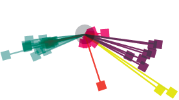2015
- East Belfast and The Great War (07/11/2015)
- WW1 AND YOU - Objects, Memories, Resources (Antrim Library) (30/10/2015)
- CDDA 3D Technologies (08/09/2015 to 10/09/2015)
- WW1 AND YOU - Objects, Memories, Resources (Armagh Library) (21/08/2015)
- WW1 AND YOU - Objects, Memories, Resources (Newry City Library) (08/09/2015 to 10/09/2015)
- WW1 AND YOU - Objects, Memories, Resources (Enniskillen Library) (07/08/2015)
- The letters of WW1 widows show hardship of war (06/06/2015)
- WW1 AND YOU - Objects, Memories, Resources (Belfast Central Library) (28/05/2015)
- WW1 'agony aunt' letters found by Teesside University (23/05/2015)
- Living Legacies and the Engagement Centres’ ‘Northern Tour’ (14/05/2015
- CDDA Research Support (13/05/2015)
- Your Community in the First World War : A Roadshow (19/03/2015)
- Exciting work handling history - Féile Belfast History (20/02/2015)
- AHRC & Connecting Communities festival 2015 - East Belfast and the Great War (07/02/2015)
- Green Impact Awards 2015 (22/01/2015)
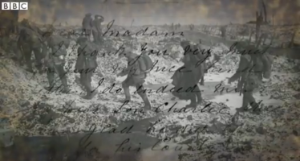 A group of letters written by the widows of husbands killed in the First World War are to be made public for the first time.
A group of letters written by the widows of husbands killed in the First World War are to be made public for the first time.
They were all written to Mary Pennyman, who was secretary of a benevolent fund for the King's Own Scottish Borderers.
The letters demonstrate the financial and emotional hardship that these women suffered after the loss of their husbands.
Please click the image to view video
Click here to view the article on the BBC website dated 7th November 2015
|
Living Legacies 1914-18 through Center for Data Digitisation and Analysis to digitise Pennyman Letters. Letters sent from women whose loved ones died in World War One have been rediscovered and will be digitised. The 120 documents were found at Ormesby Hall, Middlesbrough and had been sent to Mary Pennyman, whose family then owned the property. She wrote back to the women, offering words of comfort and advice. Teesside University has received a grant of £9,700 from the Heritage Lottery Fund to help make the letters available online to the public. "Researching the lives of the women who wrote [the letters] is a wonderful opportunity to reflect upon the cost of war and to build a picture of the challenges faced at the time and the strength it took to survive. "Many commemorative projects focus on the dead but this one will focus on those who had to live on," said Dr Roisin Higgins, senior history lecturer at Teesside University, who is leading the project. One letter sent to Mrs Pennyman was sent by Bessie Walker, whose husband was killed six weeks after they got married. "I try to be a comfort to his poor old dad and mother. "Sometimes wish I could be old with them, as life feels rather empty at times," she wrote in the letter. Ivor Crowther, head of Heritage Lottery Fund North East, said: "The Pennyman letters are an extraordinary discovery and provide an incredibly personal insight into the ultimate cost of the First World War." The letters are being stored in Teesside Archives and the project to digitise and put the letters online for the public to see is expected to take three years. |
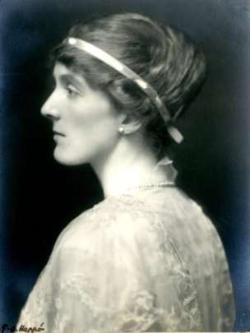 |
|
Mary Pennyman, whose husband's family lived at Ormesby Hall for around 400 years, would write back to women whose loved ones had been killed - IMAGE E. O. Hoppé |
||
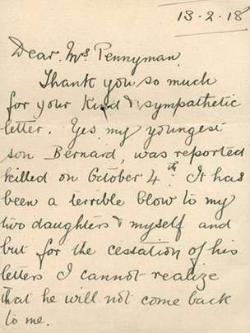 |
||
"But for the cessation of his letters I cannot realise that he will not come back to me" - Letter Teeside Archives |
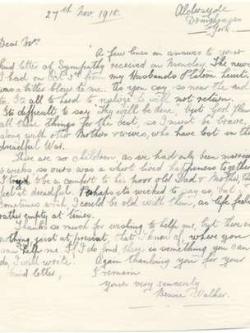 |
"There are no children, as we had only been married 6 weeks, so ours was a short lived happiness together" - Letter Teeside Archives |
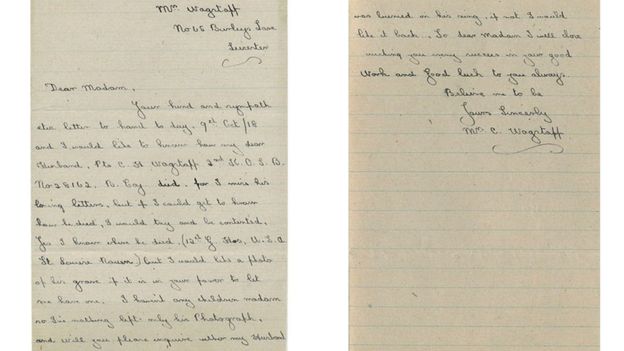 |
|
"I would like to know how my dear husband died for I miss his loving letters" - Letter Teeside Archives |
|
Click here to view the article on the BBC website dated 30th October 2015
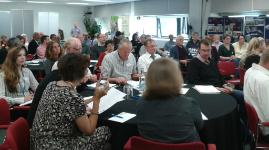 The beginning of September saw the first, all-centre, collaborative series of roadshows as the teams from the five AHRC-funded WW1 Public Engagement Centres (http://ww1engage.org.uk) gathered in three venues across the North of England to connect WW1 research agendas and communities.
The beginning of September saw the first, all-centre, collaborative series of roadshows as the teams from the five AHRC-funded WW1 Public Engagement Centres (http://ww1engage.org.uk) gathered in three venues across the North of England to connect WW1 research agendas and communities.
Community Roadshow Review by Michael Noble, Community Liaison Officer, Centre for Hidden Histories: Community, Commemoration and the First World War.
For three days, we each participated in a range of events, which sought to uncover and make salient the ways in which the Centres can most effectively work alongside communities in interrogating the legacies of the war.
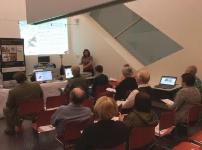
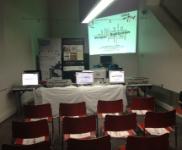 The Living Legacies team, along with Centre for Data Digitisation and Analysis (CDDA), travelled first to the Imperial War Museum North, for a stimulating day of conversations, roundtable discussions and a lively, digitisation workshop, led by the LL/CDDA team. The workshop was well-attended by local historians, community representatives and individual researchers, and included an overview of the Centre’s role in working to guide and support community research efforts.
The Living Legacies team, along with Centre for Data Digitisation and Analysis (CDDA), travelled first to the Imperial War Museum North, for a stimulating day of conversations, roundtable discussions and a lively, digitisation workshop, led by the LL/CDDA team. The workshop was well-attended by local historians, community representatives and individual researchers, and included an overview of the Centre’s role in working to guide and support community research efforts.
There was a particular interest in how digitisation, and website design, can help to disseminate and conserve the significant work carried out by groups researching the war. CDDA, led by Elaine Reid, demonstrated the technical expertise, and indeed, high-spec equipment, required to undertake such a process. This section of the programme stimulated serious discussion as to the long-term approach required when first writing a grant application.
| Sophie Long - giving a short presentation on Living Legacies 1914-18 | Elaine Reid - giving a presentation on the Centre for Data Digitisation and Analysis and their services | Within the previous presentation their is referance to a video, please see above for the same |
The next venue on the schedule was Leeds City Museum, where we were kindly facilitated by staff and colleagues. Living Legacies and CDDA ran another digitisation workshop, where participants shared their experiences of using various online resources, such as IWM’s ‘Lives of the First World War’, and made constructive suggestions for methods of effectively sharing and preserving research outputs.
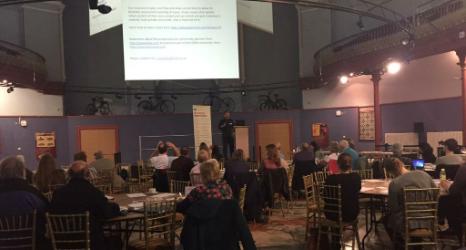
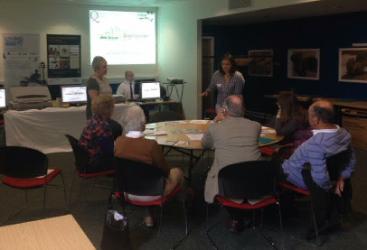 Those present from the Living Legacies centre also attended a roundtable discussion which looked at a number of critical questions, one of which asked how the Engagement Centres could best assist community research projects. The conversation led to some shared conclusions, amongst which were the need for some centres to better make publics aware of their role, in order to optimise the knowledge-exchange and collaborate more effectively.
Those present from the Living Legacies centre also attended a roundtable discussion which looked at a number of critical questions, one of which asked how the Engagement Centres could best assist community research projects. The conversation led to some shared conclusions, amongst which were the need for some centres to better make publics aware of their role, in order to optimise the knowledge-exchange and collaborate more effectively.
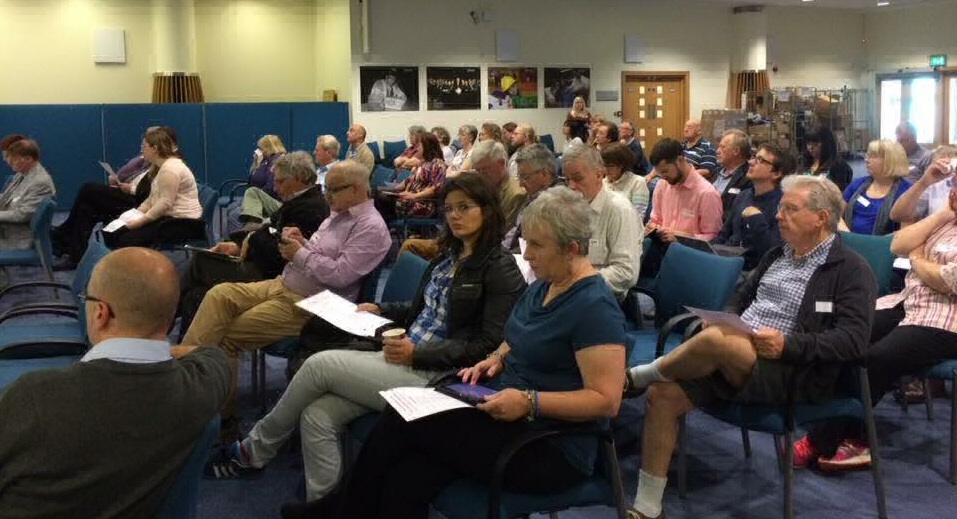
The final day of the Northern Tour was held at Newcastle University, with Living Legacies director, Prof. Keith Lilley, opening the event by outlining the role and remit of the Engagement Centres, and appealing to interested groups to make connections with, and work alongside, such Centres. We enjoyed thought-provoking presentations from Tynemouth WW1 project, and others, some of whom the Living Legacies centre is now working with closely through collaborative projects funded through the Centre.
Having thus far carried out a great deal of public engagement work in Northern Ireland, we were delighted to find that the levels of local interest in the war are matched by communities across the North of England. We want to thank our colleagues at the other Centres for helping to coordinate such a comprehensive programme of events, to all of the venues for kindly hosting us, and to those community groups and researchers who made the roadshows so worthwhile. We look forward to working together in the future.
Centre for Data Digitisation and Analysis (CDDA)
School of Geography, Archaeology and Palaeoecology
Queen’s University Belfast
 The Centre for Data Digitisation and Analysis (CDDA) is based in the School of Geography, Archaeology and Palaeoecology (GAP), and is amongst the leading Digital Humanities groups in both the UK and Ireland.
The Centre for Data Digitisation and Analysis (CDDA) is based in the School of Geography, Archaeology and Palaeoecology (GAP), and is amongst the leading Digital Humanities groups in both the UK and Ireland.
Founded in 1999 the centre has consistently pioneered linkages between information technology and humanities research.
The unit is comprised of a team of highly skilled and dedicated staff who operate over £250K of specialised digitisation equipment.
CDDA has four key aims:
- To continue to be a leading, not-for-profit, digitisation unit.
- To deploy resources, which it has created for scholarly outputs, such as traditional monographs and e-journal articles.
- To be at the forefront of developing new data management methodologies.
- To collaborate with local and international colleagues, in obtaining grants, to further Digital Humanities and Social Science research objectives.
CDDA is fully committed to and supports the aims of Vision 2020.
We welcome you to visit our web site, which provides details of projects that we have worked on and assistance that we can offer to both you and your colleagues: www.qub.ac.uk/cdda
Contact:
If you have any inquiries please contact:
Ms Elaine Reid
Email: Elaine.Reid@qub.ac.uk
Tel: +44 (0) 28 90972513
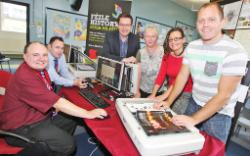 St Mary’s University College played host for the first Féile History Day as researchers and staff put out the call to “co-create” the festival’s history to date.
St Mary’s University College played host for the first Féile History Day as researchers and staff put out the call to “co-create” the festival’s history to date.
The initiative, a joint collaboration between Féile staff and Queen’s University, aims to develop the history of the West Belfast festival from its inception back in 1988, with the goal to produce an interactive exhibition, book and online archive. Research Fellow Dr Michael Pierse said the team are experiencing a “groundswell of interest” around the project, which will ultimately tell the community’s story.
“We are putting out the call for everything Féile related with regards to this project, photos, leaflets, programmes, a binlid from the Binlids play, a hurley from the Poc Fada, costumes from the Féile parade, original painting from an exhibition or snippets from video or audio recordings are all welcome,” he said.
“2015 maps the 27th year of the history of Féile and the community are front and centre when it comes to narrating that story.
“Féile isn’t just another festival, it’s deeply embedded in the community, it’s the most dynamic community festival on these islands.
“What we are trying to achieve is a participating project with the communities help. We aren’t allowing the story, the history of the Féile to be told from above so to speak, we want to hear the stories behind any memorabilia the community might have. As we start the archive we are looking and considering a documentary as well on Féile history.”
Researcher on the project Feargal Mac Ionnractaigh will also be working on the project.
“We are three years away from Féile turning 30 so now is as good a time as any to really start to gather as much historical items as we can. We are really looking forward to seeing what people will contact us with.”
http://belfastmediagroup.com/exciting-work-handling-history/
Please visit www.FéileBelfastHistory.com for more information
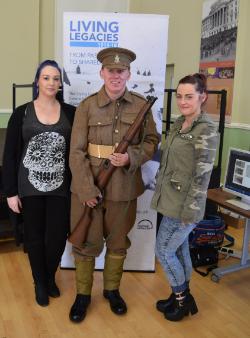 Saturday 6th June saw Living Legacies 1914-18 visit East Belfast, for the third in our series of collaborative events with the successful East Belfast and the Great War research group. This particular event was also the first of the AHRC-sponsored, Connected Communities' festival, which runs throughout June. Other events which are part of the Festival can be found on our website.
Saturday 6th June saw Living Legacies 1914-18 visit East Belfast, for the third in our series of collaborative events with the successful East Belfast and the Great War research group. This particular event was also the first of the AHRC-sponsored, Connected Communities' festival, which runs throughout June. Other events which are part of the Festival can be found on our website.
Along with History Hub Ulster, 'Row on Row' and the Hounds of Ulster, the East Belfast Network Centre played host to a range of groups who each had an important and unique approach to commemorating and exploring the Great War.
Living Legacies 1914 were supported by the Digitisation Team (Centre for Data Digitisation and Analysis) from Queen's University Belfast, and were kept busy throughout the day, as they digitally recorded over one hundred, original WW1 artefacts.
Each contributor had an interesting story to share, and we were delighted to be able to capture these, and preserve East Belfast's war stories.
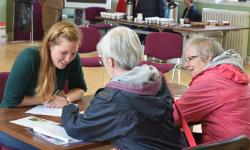 One contributor, a relative of Private Alec Cairns, from Lisburn, who served in the 4th Canadian Infantry Battalion, brought along some of Alec's WW1 memorabilia, and shared his story with us. Alec is thought to have joined up as a young man, aged around 16 or 17, and is likely to have concealed his age in order to enlist. This is also thought to be the reason for his move from Lisburn to Canada.
One contributor, a relative of Private Alec Cairns, from Lisburn, who served in the 4th Canadian Infantry Battalion, brought along some of Alec's WW1 memorabilia, and shared his story with us. Alec is thought to have joined up as a young man, aged around 16 or 17, and is likely to have concealed his age in order to enlist. This is also thought to be the reason for his move from Lisburn to Canada.

The family believe that Alec was wounded in the Second Battle of Ypres, and died in a military hospital shortly afterwards, in 1915. He is buried in Boulogne's Eastern Cemetery and the family visited his grave for the 100th anniversary last year. Several items of Alec's were digitally captured, and will be available on our database shortly.
Along with the oral history and object sampling, Saturday's event featured two presentations on particular aspects of the war and its explorations, which were both well-attended. Historian Philip Orr gave a talk on 'The Shipyard and the Home Front during the First World War', which was particularly poignant with the two, infamous cranes visible through the windows. He presented some of the lesser-known narratives of East Belfast's volunteers, and argued that, for many, the training, travel and comradeship offered by the British Army was in sharp relief to the prospects offered elsewhere.
East Belfast and the Great War project coordinator, Jason Burke, then spoke to an interested audience about the group's work to date, including some of the research methods being used to gather and record the stories of the local people whose lives were affected by the Great War.
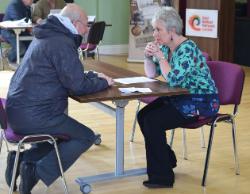 We were very impressed by the continued local interest in the war, and grateful to the AHRC for funding the event, and to the East Belfast team for allowing us to work with them on this timely endeavour.
We were very impressed by the continued local interest in the war, and grateful to the AHRC for funding the event, and to the East Belfast team for allowing us to work with them on this timely endeavour.
Other events which are part of the Connection Communities' festival 2015 can be found on AHRC website.
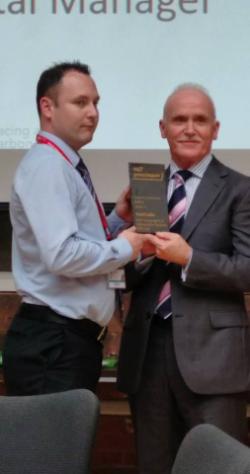 Queen’s University Belfast has had another brilliant year of Green Impact in 2014/15, with impressive numbers of staff and student participation, continuing to build a strong sustainability community across the university within the fourth year of the initiative.
Queen’s University Belfast has had another brilliant year of Green Impact in 2014/15, with impressive numbers of staff and student participation, continuing to build a strong sustainability community across the university within the fourth year of the initiative.
Staff have engaged in various local campaigns throughout the year, which has been a positive indicator of the enthusiasm staff have to work collaboratively, and a great way to engage other staff members.
Photo :- Green Impact award 2015, presented to Mr Anthony Anderson by Mr James O'Kane
Antrim Library
Antrim sent its fair share of young men to serve their country in World War One. Many, sadly, did not return. But due to bureaucracy and a lack of money, a permanent memorial was never built in the town. Now, former Antrim Guardian reporter Alvin 'Alfie' McCaig hopes that his forthcoming book dedicated to the local men who fought and died in the Great War, will be a...
Lasting legacy to Antrim's fallen
by Clare Weir picturedesk@antrimguardian.co.uk (4th June 2015 Antrim Guardian page 12)
A FORMER Antrim Guardian reporter is hoping that his forthcoming book about the men from Antrim who served in World War One will act as a permanent memorial to the fallen from the town.
Unlike some of the outlying towns and villages in the borough, there is no inscribed war memorial in Antrim, a fact which was discussed at one of a number of talks as part of the Libraries NI and Living Legacies 1914-18 event, which took place recently in Antrim Library.
The event was aimed at those interested in finding out more about WWl and gave local people the opportunity to explore their ancestors and to record and preserve their stories and memorabilia.
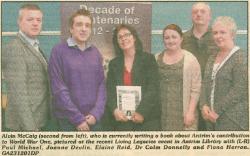 Researchers from Living Legacies were on hand with scanning equipment to help people digitally record personal legacies and reminders from the Great War for the benefit of future generations.
Researchers from Living Legacies were on hand with scanning equipment to help people digitally record personal legacies and reminders from the Great War for the benefit of future generations.
Dr Johanne Devlin Trew from the University of Ulster began the proceedings, followed by Tom Thorpe of the Western Front Association, Antrim and Down Branch, who delivered a presentation entitled, Exploring WWl through the WFA.
Archaeologist Dr Colm Donnelly of Queen's University discussed Exploring WWl through Archaeology.
The final speaker was Mr McCaig, now a BBC NI sports journalist and a keen member of Antrim Historical Society, who gave a presentation about local boy soldiers who joined up and who is currently putting the finishing touched to a book about the town's involvement in the conflict.
 He said that around 250,000 underage teenagers went to fight in the Great War.
He said that around 250,000 underage teenagers went to fight in the Great War.
One of those was 'Budgie' McCabe, related to the family of butchers in Antrim, and another was Robert McCormick, from Kiln Entry, off Church Street.
Mr McCaig explained how so many boys slipped through the procedural cracks.
"The age to join up was 19-35," he said.
"Some joined the 9th Royal Inniskilling Fusiliers. They trained at Shane's Castle. People at the Antrim recruiting office across the road from where the library now stands - would have known who a lot of these boys were and would have known they were not old enough." During his presentation Mr McCaig discussed a well-known painting by JP Beadle, 'Battle of the Somme, the Attack of the Ulster Division', which hangs in Belfast City Hall and which features the South Antrim Volunteers.
"Most men joined the army straight from the UVF, which was very strong in Antrim," he said.
He said that Killead 'came out very strongly' for the war and that the Dungonnell UVF company provided the building blocks for the local war effort.
"Most underage soldiers gave their age as 19 and three months, which was the spoof age," he revealed.
As buglers and drummers in bands were allowed to join up early, many were 'very naughty' and joined up that way, he said.
One of the men who went to war as a teenager was Lance Corporal Jackson, who it is said killed or wounded ten Germans, who were standing on a parapet firing at the Royal Irish Rifles, earning him the Distinguished Conduct Medal and Military Medal.
 Mr McCaig pointed to the fact that many local areas are named after some of the bloodiest battles, like Bourlon Road, named for the Battle of Cambrai, and Menin Road, the notorious route between Ypres and Menin.
Mr McCaig pointed to the fact that many local areas are named after some of the bloodiest battles, like Bourlon Road, named for the Battle of Cambrai, and Menin Road, the notorious route between Ypres and Menin.
Indeed, as was pointed out by Mr McCaig and corroborated by some members of the audience, many of the houses were 'soldiers' cottages', built for ex-servicemen coming home from war.
One of the local heroes of the conflict was Albert Whiteside, described by Mr McCaig as a 'star soldier', a son of Samuel Whiteside, a grocer on High Street.
Whiteside was said to have been underage when he joined the UVF, but went on to become a Sergeant in the South Antrims and was injured on July 1 1916.
He rose to become a Company Sergeant Major, the highest rank for a Non-commissioned Officer, and later applied for a commission and became a Second Lieutenant with the 14th Royal Irish Rifles, or the YCVs.
He was killed fighting in Cambrai, with a colleague reporting how he saw both of Whiteside's legs blown off after a shell dropped on him.
Still conscious, he urged his men to 'go on and not worry about him'.
The witness said he passed by later and said: "There was not the slightest question he was dead. I knew him well, I had heard him sing at a YMCA concert a little while before."
Albert Whiteside was only 20 years old and tragically, after making enquiries, his father Samuel received a letter to inform him that his son was dead - 11 months after his death.
"This was very typical of the anguish that families went through," said Mr McCaig.
In 1921, the grocer was walking home from First Antrim Presbyterian church and was knocked down and killed.
Mr McCaig said that at his inquest, Whiteside was described as 'never having been the same' after the death of his only son.
"Albert would have taken over the business, and by 1923 the grocers disappeared, that finished the business."
There are many more tragic stories, like that of George Green of Loanends, who died exactly a month before the Armistice, and Hugh James Thompson, a private killed at Gallipoli in 1915, one of the first to join Kitchener's Army.
Mr McCaig said that at the start of the war many joined English and Scottish regiments, like Albert Grainger from Summerhill, who fought with the Black Watch.
 But it wasn't just underage men who perished - John Cooley was a Catholic from Dungonnell who joined the Leinster Regiment of the 16th Irish Division and who was 49 when he died.
But it wasn't just underage men who perished - John Cooley was a Catholic from Dungonnell who joined the Leinster Regiment of the 16th Irish Division and who was 49 when he died.
He is said to have been born in Killead and had fought at Gallipoli.
Mr McCaig said that countless men, many of them mill workers, joined up from the Millview, Abbeyview and Raceview areas in Muckamore, among them Corporal Charles Crookes, who was killed in action in April 1918.
Willie Allen, son of Jack Allen, joined up in 1914 and was badly injured, losing the power in his arm for the rest of his life.
Mr McCaig said that many of the men who were damaged by war were unable to work in the jobs that they had done previously.
Willie had worked in the mill, but because of his injury became a lollipop man at Kirk's Corner in Antrim town centre.
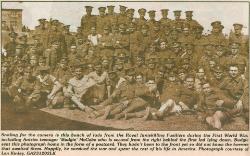 Mr McCaig said that he decided to write his book after attending his first night at Antrim Historical Society.
Mr McCaig said that he decided to write his book after attending his first night at Antrim Historical Society.
"I said, let's do a talk on the anniversary of World War I, and then someone called my bluff
and said 'why don't you do it?'.
"As I went on, I realised it was more than just a talk."
He said that newspapers from the time were 'fantastic', adding:
"They are very very detailed and have reams of stuff."
Mr McCaig has also spoken to families, gone through service records and has even sent a researcher to the National Archive in Kew.
Answering questions from Ulster Unionist councillor and Antrim British Legion
Chairman Paul Michael, he agreed that Antrim town has no collective history of the First World War and that there was a 'sense of shame' in the town at the time, that there was no permanent memorial.
He said that in 1919, a meeting at the Protestant Hall was organised to decide how to remember the men of Antrim.
"It was decided that instead of an obelisk or statue, a memorial would be placed in the foyer at the new Technical School for Antrim for everyone to see," he said.
However due to red tape and a lack of money, the project never came to fruition.
"In 1924, the war guns were brought to town, lots of towns had German guns which
had been captured, and it was said at the time that it was basically a disgrace that there was no memorial, that it got jammed.
"Local churches had a roll of honour, the Protestant Hall had a list of men that were born and reared in the town, but it was seen as a slight on the town that they never had names on a war memorial."
Now Mr McCaig said that he hopes that his book can act as, or help inspire, a lasting war memorial in Antrim.
Abstract taken from Antrim Guardian dated 4th June 2015
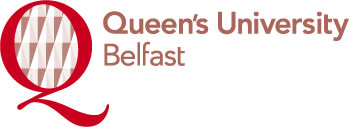

Some of the latest and most innovative forms of scanning are the use of 3D techniques. Please visit http://go.qub.ac.uk/3Dtechnologies to get more information and see some sample digital captures.
Armagh Irish and Local Studies Library
 The Living Legacies 1914-18 team were pleased to host another WW1 and You! digitisation workshop on Wednesday May 13, 2015 in Armagh Local and Irish Studies Library. There were several talks throughout the afternoon, including an introduction to digitisation by Johanne Devlin Trew of UU, followed by William Blair of NMNI who explored the WW1 significance of the collections at the Ulster Museum. Brenda Winter-Palmer and graduating student actors from the Queen’s University drama dept. then brought WW1 to life through an excerpt from Brenda’s play, The Medal in the Drawer. The workshop attendees then entered into the actors’ role play, putting questions to them about life in the WW1 trenches. Local Armagh historian, Joe Centre, continued with a presentation entitled, Exploring WW1 in the Community: Armagh Heroes, which looked at the involvement of several local families on the war and home fronts.
The Living Legacies 1914-18 team were pleased to host another WW1 and You! digitisation workshop on Wednesday May 13, 2015 in Armagh Local and Irish Studies Library. There were several talks throughout the afternoon, including an introduction to digitisation by Johanne Devlin Trew of UU, followed by William Blair of NMNI who explored the WW1 significance of the collections at the Ulster Museum. Brenda Winter-Palmer and graduating student actors from the Queen’s University drama dept. then brought WW1 to life through an excerpt from Brenda’s play, The Medal in the Drawer. The workshop attendees then entered into the actors’ role play, putting questions to them about life in the WW1 trenches. Local Armagh historian, Joe Centre, continued with a presentation entitled, Exploring WW1 in the Community: Armagh Heroes, which looked at the involvement of several local families on the war and home fronts.
 To conclude the afternoon, Councillor Sylvia McRoberts, MBE, introduced a most poignant poetry reading by Kevin McEneaney of two WW1 themed award-winning poems written by young Armagh poets, Caoimhe McCann and Clare Mackle (both aged 11 years old). These young writers were winners of the 2015 Lena Mackrel Poetry competition.
To conclude the afternoon, Councillor Sylvia McRoberts, MBE, introduced a most poignant poetry reading by Kevin McEneaney of two WW1 themed award-winning poems written by young Armagh poets, Caoimhe McCann and Clare Mackle (both aged 11 years old). These young writers were winners of the 2015 Lena Mackrel Poetry competition.
Highlights of material digitised at the event included the Canadian Casualty Cross awarded to a young man T.G. Henry originally from Armagh who joined the 12th Canadian Machine Gun Corps and was sadly killed in 1917. The medal, which was returned to the family in Armagh, was brought in by his great niece. Another lady brought in a special official navy photo of her grandfather, who served as a fireman aboard the ill-fated Lusitania and was listed as killed in the disaster, although he actually survived!
Photo 1 - Kevin McEneaney; Photo 2 - Sylvia McRoberts
19th March 2015 from 12.30pm to 4.30pm

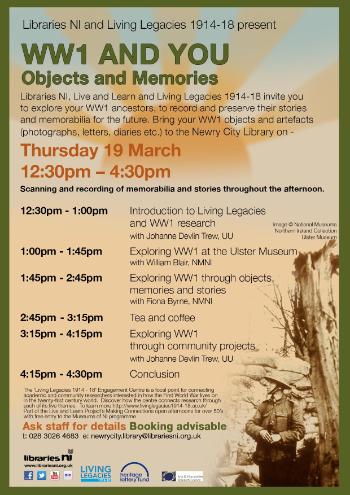
LibrariesNI at Newry City Library
and Living Legacies 1914-1918.
WW1 AND YOU
Objects, Memories, Resources
Libraries NI and Living Legacies 1914-18 invite you to explore the lives of your WW1 ancestors, and help to record and preserve their stories and memorabilia for the future. As part of an afternoon of talks and discussion on how the war affected everyday lives, the research team from the Centre will be on hand to give free information and advice on your WWI family heirlooms and memorabilia in personal collections. Free information and advice for budding family researchers from experts in family history.
So please do come and bring your WW1 objects and artefacts (photographs, letters, diaries etc.) to this event at Newry City Library.
Scanning and recording of memorabilia and stories throughout the afternoon.
Thursday 19th March 2015 12.30pm - 4.30pm
Please click the poster for further details
20th February 2015 from 12.30pm to 4.30pm

LibrariesNI at Enniskillen Library
and Living Legacies 1914-1918.
WW1 AND YOU
Objects, Memories, Resources
Libraries NI and Living Legacies 1914-18 invite you to explore the lives of your WW1 ancestors, and help to record and preserve their stories and memorabilia for the future. As part of an afternoon of talks and discussion on how the war affected everyday lives, the research team from the Centre will be on hand to give free information and advice on your WWI family heirlooms and memorabilia in personal collections. Free information and advice for budding family researchers from experts in family history.
So please do come and bring your WW1 objects and artefacts (photographs, letters, diaries etc.) to this event at Enniskillen Library.
Scanning and recording of memorabilia and stories throughout the day.
Friday 20th February 2015 12.30pm - 4.30pm
Please click the poster for further details
East Belfast and the Great War
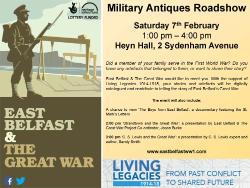 Living Legacies Supported Project: East Belfast and the Great War
Living Legacies Supported Project: East Belfast and the Great War
On Saturday 7th February the Living Legacies Team visited St Mark's Parish Church in East Belfast. We were delighted to support the East Belfast research group in their second roadshow, as they continued their efforts in sharing the stories of the men and women from East Belfast who served at home and abroad during the Great War.
This was the second event we had co-organised with Jason and his colleagues, and following the success of October's roadshow at Willowfield Parish Church, we were looking forward to speaking with more members of the public about their connections to, and interest in, the legacy of WW1.
Our digitisation unit, provided by our supporting partner CDDA (Centre for Data Digitisation and Analysis), were on hand to sample and record images of the objects which were brought in by members of the public. We received some fascinating artefacts for digitisation, including an extensive, personal collection of war memorabilia which included wire cutters, a German rifle, WW1 helmet and Royal Irish Regiment badges.
Whilst the digitisation team worked hard to record these images, our Heritage Officer Fiona Byrne assessed and discussed the war memorabilia with the owners of the objects, and provided some advice on conservation. A short guide to maintaining your historical objects is available here.
In addition to the above activities, there were two expert lectures, both well-attended, throughout the afternoon. Firstly. C.S. Lewis author Sandy Smith, spoke about Lewis' own war experience, noting that St Mark's was his former parish. After this, East Belfast project lead Jason Burke presented some original research on Strandtown's war involvement. Jason had recently visited archives in Dublin and viewed the original letters, penned by men belonging to St Mark's Parish Church. Jason's research has been transformed into a short film, available to view here.
We were thoroughly impressed by the progress which the research group have made, since they were successfully awarded HLf funding in 2014. We look forward to collaborating with them further as they uncover more interesting and unexplored stories about East Belfast's WW1 story.
Belfast Central Library
Thursday 22nd January saw the first Living Legacies public engagement event of 2015, and the third of seven collaborative roadshows with Libraries NI. The format was broadly similar to previous events, with some of our academic specialists giving presentations on the remit and objectives of the Centre, and the Digitisation Unit on-hand to sample and record artefacts brought in by members of the public.
In addition to this, we were delighted to host some special guests as part of our event. Firstly, Dr. Andrew Murrison MP, the Prime's Minister's special representative for the Centenary Commemoration for the First World War, gave some eloquent and encouraging remarks on his experience of how Northern Ireland is beginning to engage with the complex matter of how to remember the Great War. Dr. Murrison's comments reflected how the people of this region are taking the opportunity to explore the nuances of local experiences of the War, and in doing so, dispel some of the myths which were a mark of a deeply divided society. The work which has been carried out so far has begun to lay the foundations for strong, civic participation in the major centenaries which fall in 2016.
There are two research groups who have anticipated the significance of these anniversaries. We were lucky to have the project leads from both groups attend the roadshow and present some of their work to the assembled guests. Sean O'Hare of the 6th Connaught Rangers Research Project, which was formally launched at the Falls Road Library in August 2014, gave an excellent presentation on the group's work. The project has been ongoing since 2006 and aims to tell the hitherto unknown story of the 6th Connaught Rangers regiment, comprised of men who hailed mainly from the Falls Road area of Belfast. The group have collaborated with Centre CI, Professor Richard Grayson, to produce a publication, available for purchase here: http://www.amazon.co.uk/The-6th-Connaught-Rangers-Nationalists-ebook/dp/B0071A83MO. The Connaught Rangers story is just one of many which are now coming to the fore, as the centenary of the First World War creates space for nationalist communities to engage with their heritage.
The second community-based research project to present their work was East Belfast and the Great War, a group whom we supported in their successful bid for Heritage Lottery Funding early in 2014. Since the project's formal launch at Stormont Buildings in August 2014, project leader Jason Burke and his team of volunteer researchers have been working tirelessly to trace and document every East Belfast connection to the war. Jason gave a lively presentation on the aims and methods of the project. East Belfast and the Great War are co-hosting a workshop with Living Legacies on Saturday 7th February, details of which are available .
Click here to view an article in the Belfast Telegraph dated 23rd January 2015

